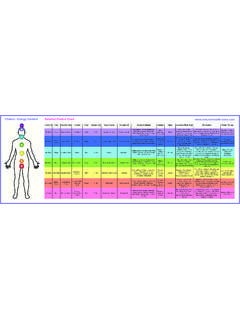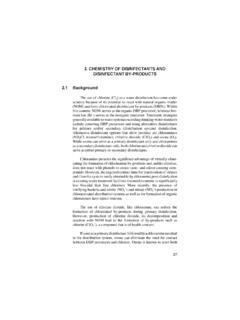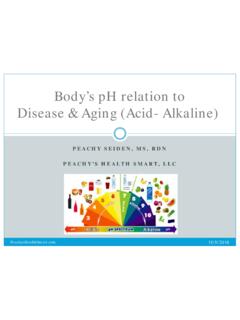Transcription of The Acid & Alkaline Food Chart - Natural Health Zone
1 Definitive listing of acid & Alkaline foods in an easy to easy to print Chart The Acid & Alkaline Food Chart Ph Value Food Chart Clarification As you are probably aware, there are many different conflicting food charts available online. So before we start I want to clarify why/ how we have classified the foods contained within this list. I know it is quite confusing to see such differences in the charts. This amount of conflicting information is the main reason I prepared this It is based on the research of the Alkaline Diet pioneer, Dr Young and, in my opinion, is the most accurate. The reason that other charts show such disparity is because they base their classifications on the readings for the Potential Renal Acid Load research (PRAL). This is not an accurate source for this purpose. The reason for this is, to test for PRAL they basically burn the food at an extreme temperature and then take a read of the ash that is left behind and what it s pH is.
2 While this does give a read of its alkalinity from the mineral content of the food, this is only half the picture. By burning it at such a high temperature they also burn away all of the most acid-causing content of the food, namely sugar. That is why on some charts high sugar fruits are listed as Alkaline (!!?). Bananas for instance are high in the Alkaline mineral potassium, BUT they are also 25% sugar which makes them very acidifying when we consume them. So, basically, the main difference between the charts comes down to one simple thing: Some charts determine acidity or alkalinity on the food before it is consumed and others (like mine) are more interested in the effect the food has on the body after it has been consumed. Personally, I have no interest in what a food is before I ve eaten it I want to know whether it will alkalize or acidify my body. Make sense? I hope this helps clear things up. The At-A-Glance Acid/ Alkaline Food List MORE EAT LESS pH Alkaline water Sea salt Grasses Cucumber Kale Kelp Spinach Parsley Broccoli Sprouts (soy, ) Sea Vegetables (Kelp)
3 Green drinks All Sprouted Beans/ Sprouts Avocado Beetroot Pepper Cabbage Celery Collard/Spring Greens Endive Garlic Ginger Green Beans Lettuce Mustard Greens Okra Onion Radish Red Onion Rocket/Arugula Tomato Lemon Lime Butter Beans Soy Beans White Haricot Beans Chia/Salba Quinoa Artichokes Asparagus Brussels Sprouts Cauliflower Carrot Chives Zucchini Leeks Baby Potatoes Peas Rhubarb Swede Watercress Grapefruit Coconut Buckwheat Spelt Lentils Tofu Other Beans & Legumes Goat & Almond Milk Most Herbs & Spices Avocado Oil Coconut Oil Flax Oil Black Beans Chickpeas/Garbanzos Kidney Beans Cantaloupe Currants Fresh Dates Nectarine Plum Sweet Cherry Watermelon Millet Oats/Oatmeal Soybeans Rice/Soy/Hemp Protein Freshwater Wild Fish Rice & Soy Milk Brazil Nuts Pecan Nuts Hazel Nuts Sunflower Oil Grape-seed Oil Fresh, Natural Juice Ketchup Mayonnaise Butter Apple Apricot Banana Blackberry Blueberry Cranberry Grapes Mango Orange Peach Papaya Pineapple Strawberry Brown Rice Oats Rye Bread Wheat Whole meal Bread Wild Rice Whole meal Pasta Ocean Fish Alcohol Coffee & Black Tea Fruit Juice ( Cocoa Honey Jam Jelly Mustard Rice Syrup Soy Sauce Vinegar Yeast Dried Fruit Beef Chicken Eggs Farmed Fish Pork Shellfish Cheese Dairy Artificial Sweeteners Syrup Mushroom Highly Alkaline Moderately Alkaline Mildly Alkaline Neutral/ Mildly Acidic Moderately Acidic Highly Acidic CAN BE INCLUDED IN YOUR 20% ACID List of Alkaline Foods Eat these Alkaline foods freely!)
4 Try to incorporate as many as you can into your daily Vegetables! Asparagus Broccoli Chili Capsicum/Pepper Zucchini Dandelion Snow peas Green Beans String Beans Runner Beans Spinach Kale Wakame Kelp Collards Chives Endive Chard Cabbage Sweet Potato Coriander Basil Brussels Sprouts Cauliflower Carrot Beetroot Eggplant Garlic Onion Parsley Celery Cucumber Watercress Lettuce Peas Broad Beans New Potato Pumpkin Radish Sprouts! Soy Sprouts Alfalfa Sprouts Amaranth Sprouts Broccoli Sprouts Fenugreek Sprouts Mung Bean Sprouts Quinoa Sprouts Radish Sprouts Spelt Sprouts Fruit! Avocado Tomato Lemon Life Grapefruit Fresh Coconut Nuts & Seeds! Almonds Coconut Flax Seeds Pumpkin Seeds Sesame Seeds Sunflower Seeds Oils! Avocado Oil Coconut Oil Flax Oil Olive Oil Amaranth Buckwheat Brown Rice Chia/Salba Kamut Millet Quinoa Spelt Lentils Lima Beans Mung Beans Navy Beans Pinto Beans Red Beans Soy Beans White Beans Grains & Beans! Breads! Sprouted Bread Sprouted Wraps Gluten/Yeast Free Breads & Wraps Grasses!
5 Wheatgrass Barley Grass Dog Grass Shave Grass Oat Grass Dairy & Eggs! Butter Cheese Milk Whey Yogurt Cottage Cheese Ice Cream Sour Cream Soy Cheese Eggs List of Acid Foods Try to keep these foods to a maximum of 20% of your diet or avoid altogether Drinks! Alcohol Black/Green Tea Flavored Water Coffee Carbonated Water Pasteurized Juice Cocoa Energy Drinks Sports Drinks Colas Tap Water Decaffeinated Drinks Meat! Bacon Beef Clams Corned Beef Eggs Lamb Lobster Mussels Organ Meats Venison Fish Sauces! Mayonnaise Ketchup Mustard Soy Sauce Pickles Vinegar Tabasco Tamari Wasabi Fruit! Apple Apricot Currants Dates Grapes Mango Peach Pear Prunes Raisins Sweeteners! Artificial Sweeteners Carob Corn Syrup Fructose Processed Sugar Saccharine Sucrose Honey Maple Syrup Nuts & Seeds! Cashews Peanuts Pecans Pistachios Walnuts Brazil Nuts Chestnuts Hazelnuts Macadamia Nuts Oils! Cooked Oil Solid Oil (Margarine) Oil Exposed to Heat Oyster Pork Rabbit Sausage Scallops Shellfish Shrimp Tuna Turkey Veal Raspberries Strawberries Tropical Fruits Berries Cantaloupe Cranberries Currants Honeydew Melon Orange Pineapple Plum Lookouts & Top Tips It might come as a surprise that fruits are considered to be acid- forming .
6 This is purely because of their high sugar content, and so I strongly advise that you keep fruit to a minimum. However, you don t have to avoid it completely and a piece per day as part of a balanced diet is fine. Tip #1 - Fruits Tip #2 - I Thought It Was Acid?! There are a few exceptions where intuition goes out of the window and the most obvious of these is lemons and limes being considered as Alkaline . This is because they have a high Alkaline mineral content and almost no sugar - so they have an Alkaline effect on the body after they are consumed. The same goes for tomatoes. Tip #3 - Soy & Soy Sauce Soy sauce, miso, tamari and all other fermented foods are acid- forming . This does not apply to the unfermented versions however, and soy sauce & tofu are OK to consume as part of your 20% mildly acid foods. Tip #4 - Tea & Coffee Tea & coffee are, of course, acid- forming - so if you need to cut them from your diet look for substitutes.
7 All herbal teas are Alkaline (except for the very fruity ones and green tea, which contains nearly as much caffeine as coffee). Tip #5 - Bread Bread is a tough one for many people, who rely upon it as a quick, filling part of lunch and breakfast. Try sprouted breads raw breads - which are mildly Alkaline . If these are hard to find go for wraps instead of sandwiches and look for yeast free/gluten free varieties. Tip #6 - Hydration Staying properly hydrated is probably the most important element of the Alkaline diet.







